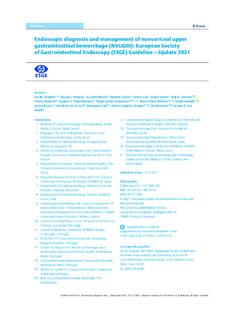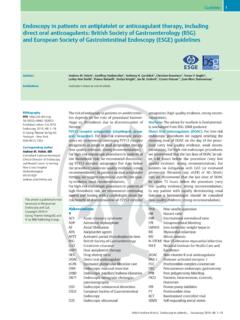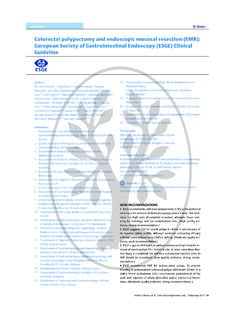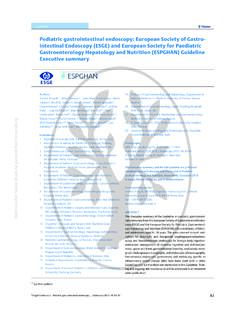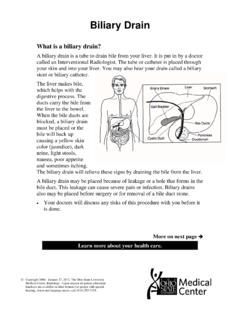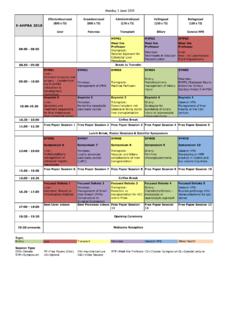Transcription of Biliary stents: models and methods for endoscopic stenting ...
1 review 617. Biliary stents: models and methods for endoscopic stenting european society of gastrointestinal endoscopy (ESGE). technology review Authors Dumonceau1, D. Heresbach2, J. Devi re3, G. Costamagna4, U. Beilenhoff5, A. Riphaus6. Institutions Institutions are listed at the end of article. submitted Biliary stenting is widely used to palliate malig- current view of the european society of Gastroin- 22 November 2010 nant obstruction or to treat benign Biliary dis- testinal endoscopy (ESGE) about endoscopic bili- accepted after revision eases. Recently, the most important changes have ary stenting : a technology review describes the 7 December 2010. related to self-expandable metal stents (SEMSs), stent models and stenting techniques, and a sepa- Bibliography which are now available in a wide variety of de- rate clinical guideline states the evidence and rec- DOI signs, and to treatment techniques.
2 This article is ommendations regarding stenting . part of a combined publication that expresses the Published online 25 May 2011. Introduction that used for ESGE clinical guidelines;notable dif- endoscopy 2011; 43: ! ferences include the absence of key questions and 617 626 Georg Thieme Verlag KG Stuttgart New York The word stent derives from the name of an of recommendations [3]. Briefly, a search of the ISSN 0013-726X English dentist, Charles Stent (1807 1885), who relevant literature was performed in Medline invented a compound for dental impression in (via Pubmed), the Cochrane Library, Embase, and Corresponding author 1856 [1]. This compound was then used for plas- the internet, with search terms that always inclu- Dumonceau, MD, PhD. Service of Gastroenterology and tic surgery during the First World War (it served ded at least Biliary and stent plus words perti- Hepatology as a matrix around which to form tissue in the nent to specific topics.)
3 Geneva University Hospitals process of rebuilding a shattered face). Stent is The following manufacturers were contacted by Rue Gabrielle-PerretGentil 4 currently used to describe hollow tubes made of the Secretariat of the ESGE to collect technical in- 1211 Gen ve 14 plastic or of metal that are implanted into a vari- formation about self-expandable metal stents Switzerland ety of anatomical locations, most commonly ves- (SEMSs), with a maximum of two covered and Fax: +41-22-3729366. sels and urological/digestive tracts. two uncovered models allowed per manufactur- Biliary stents are used to facilitate the drainage of er: Abbott Vascular (Abbott Park, Illinois, USA), bile into the digestive tract, most frequently in the Boston Scientific (Natick, Massachusetts, USA), palliation of malignant Biliary obstruction but Conmed (Utica, New York, USA), Cook endoscopy also in benign conditions such as Biliary fistulas (Winston-Salem, North Carolina, USA), C.
4 R. Bard or benign Biliary strictures. This article is part of (Murray Hill, New Jersey, USA), Edwards Life- a publication that expresses the current view of science (Irvine, California, USA), ELLA-CS (Hradec the european society of gastrointestinal Endos- Kralove, Czech Republic), ev3 Endovascular. copy (ESGE) about Biliary stenting : this technolo- (Plymouth, Minnesota, USA), Gore Medical (Flag- gy review describes the Biliary stents that are cur- staff, Arizona, ), Leufen Medical (Aachen, rently available for endoscopic insertion and the Germany), Medinol (Jerusalem, Israel), insertion techniques, and a clinical guideline (Seoul, Korea), Optimed (Ettlingen, Germany), states the evidence and recommendations re- Sewoon Medical (Seoul, Korea), Standard Sci- garding endoscopic Biliary stenting . Tech (Seoul, Korea), Stentech (Seoul, Korea), Tae- woong (Seoul, Korea),. If there was no response, the query was repeated by the first author.
5 methods In November 2010, the manuscript was endorsed ! by the ESGE Governing Board. It was sent to the The ESGE commissioned and funded these guide- Editorial Board of the journal endoscopy for inter- lines after preliminary work from the French So- national peer review , and the final version was ciety of Digestive endoscopy [2]. For the technol- approved by all authors. ogy review , the methodology was adapted from Dumonceau J-M. et al. ESGE technology review : Biliary stenting endoscopy 2011; 43: 617 626. 618 review Plastic stents ! Stent characteristics Shape and material Most models of plastic stents are slightly curved to fit the contour of the common bile duct (CBD) and to prevent stent migration; S- shaped stents are specifically designed for draining the left bili- ary tree and pigtail stents are also available, but these latter mod- els are rarely used in the bile ducts (.)
6 " Fig. 1). Sideholes are present at both ends of many stent models in order to maintain drainage if the tip of the stent becomes impacted in the Biliary or digestive tract wall. As it has been suggested that these sideholes favor sludge formation [4], models without side- holes but with multiple sideflaps intended to prevent stent mi- gration have been developed (these are known as Tannenbaum . stents, from the German word for firtree). The Double Layer stent is an example of the Tannenbaum design. Attempts to prolong stent patency, by the addition of an antireflux valve or by the use of different coatings on the stent surface, are being tested Fig. 1 Plastic Biliary stents commonly used or found to be superior to [5, 6]. Most plastic stents are made of polyethylene, Teflon, or other models in randomized controlled trials. a Cotton-Leung stent, made of polyethylene with proximal and distal sideholes and anchoring flaps polyurethane.
7 Polyethylene stents become malleable (in other (Cook endoscopy , Winston-Salem, North Carolina, USA); b S-shaped stent words, their shape may be changed) when immersed in boiling for drainage of the left Biliary tree (EndoFlex, Voerde, Germany); c Double- water; they are softer than Teflon stents. Layer stent with no sideholes and an internal coating made of perfluor- oalkoxy material to prevent bacterial adhesion (Olympus, Tokyo, Japan);. Stent diameters d Marathon stent with no sideholes and a valve (arrow) designed to prevent The diameter of plastic Biliary stents is measured in French (Fr), a reflux of duodenal content into the Biliary tree (Cook endoscopy ). Because unit that corresponds to one third of a millimeter. Standard exter- the valve is pliable, the Marathon stent is only available preloaded on the insertion system, unlike other models . nal diameters of plastic Biliary stents are , , , and Fr; it would be difficult or impossible to introduce larger stents through most standard therapeutic duodenoscopes with " Stent insertion system.
8 This consists of a plastic guiding cathe- working channels that measure mm in diameter. ter equipped with radiopaque markers and a pushing catheter of the same diameter as the stent. These two catheters may be Stent lengths pre-assembled in a single system (single-use or reusable de- Standard plastic stent models are available in lengths ranging be- pending on manufacturer); using a pre-assembled system al- tween 5 and 18 cm but custom-made stents may be ordered from lowed a significant reduction in procedure time as compared some manufacturers (longer models may be useful in liver trans- with separate guiding and pushing catheters in an RCT [12]. plant recipients). Of note, the stated length usually indicates the Thin stents are inserted over a guide wire without a distance between the proximal and distal flaps of the stent, not plastic guiding catheter. the entire stent length, but this is not true for all models .
9 " Dilators. Bougies or balloon catheters may be useful in the case of tight strictures. Technique of plastic stent insertion Material methods This includes the following: Plastic Biliary stents are placed with their distal end protruding " Radiopaque guide wire. The numerous available models have into the duodenum, because stent placement beyond the sphinc- been described in two recent technological evaluations [7, 8]. ter of Oddi rather than across it does not prolong stent patency The most popular hybrid models have a hydrophilic tip to and increases the risk of stent migration [13]. Stent length is gen- facilitate passage of tight or tortuous strictures and a stiffer erally selected as the shortest possible that will still ensure ade- shaft to provide good trackability. quate drainage. Stents are usually positioned so that one end is Short-wire systems are available from three manufacturers, finally 1 2 cm beyond the proximal extent of the Biliary obstacle Boston-Scientific, Cook endoscopy , and Olympus (Tokyo, Ja- and the other end protrudes 1 cm into the duodenum (a long in- pan).)
10 These systems include a locking mechanism to prevent traduodenal stent portion may cause peritoneal or retroperito- the wire from slipping during exchange procedures and a neal perforation and bleeding ulcer) [14]. Stents with sideflaps short wire (185 270 cm in length as compared with the usual designed to prevent migration must be positioned with the flaps 400 460 cm). In two randomized controlled trials (RCTs) located beyond the obstacle and in the duodenum. If the ostium some of these systems allowed significant reduction in the of the cystic duct is large and is located immediately above the time needed for device exchange and for stent insertion com- proximal end of the Biliary obstacle, it may be useful to select a pared with traditional long-wire devices [9, 10]. One of these longer stent to avoid the possibility that it might swing into the systems (Fusion; Cook endoscopy ) also allows for intraductal cystic duct.


